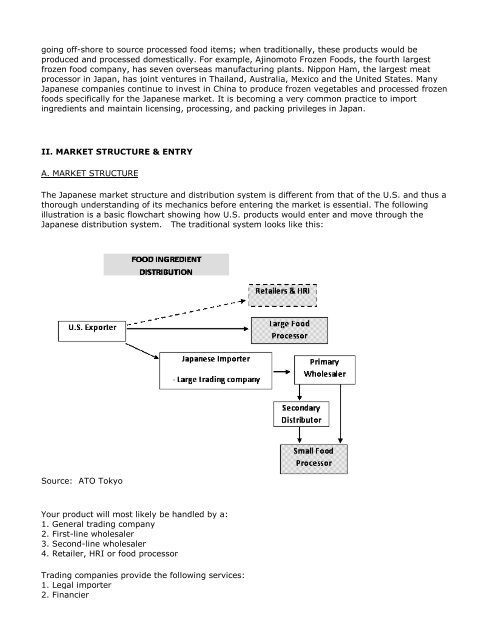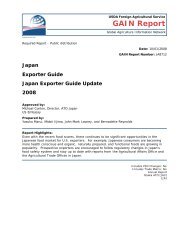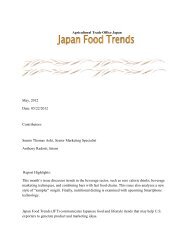Food Processing Sector Food Processing Ingredients Japan
Food Processing Sector Food Processing Ingredients Japan
Food Processing Sector Food Processing Ingredients Japan
You also want an ePaper? Increase the reach of your titles
YUMPU automatically turns print PDFs into web optimized ePapers that Google loves.
going off-shore to source processed food items; when traditionally, these products would be<br />
produced and processed domestically. For example, Ajinomoto Frozen <strong>Food</strong>s, the fourth largest<br />
frozen food company, has seven overseas manufacturing plants. Nippon Ham, the largest meat<br />
processor in <strong>Japan</strong>, has joint ventures in Thailand, Australia, Mexico and the United States. Many<br />
<strong>Japan</strong>ese companies continue to invest in China to produce frozen vegetables and processed frozen<br />
foods specifically for the <strong>Japan</strong>ese market. It is becoming a very common practice to import<br />
ingredients and maintain licensing, processing, and packing privileges in <strong>Japan</strong>.<br />
II. MARKET STRUCTURE & ENTRY<br />
A. MARKET STRUCTURE<br />
The <strong>Japan</strong>ese market structure and distribution system is different from that of the U.S. and thus a<br />
thorough understanding of its mechanics before entering the market is essential. The following<br />
illustration is a basic flowchart showing how U.S. products would enter and move through the<br />
<strong>Japan</strong>ese distribution system. The traditional system looks like this:<br />
Source: ATO Tokyo<br />
Your product will most likely be handled by a:<br />
1. General trading company<br />
2. First-line wholesaler<br />
3. Second-line wholesaler<br />
4. Retailer, HRI or food processor<br />
Trading companies provide the following services:<br />
1. Legal importer<br />
2. Financier





